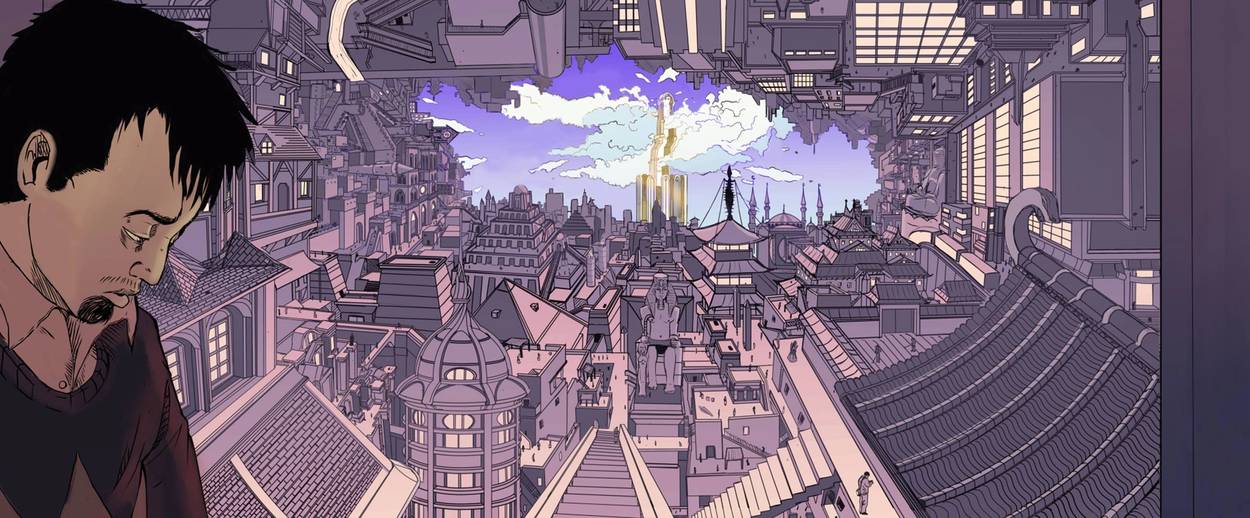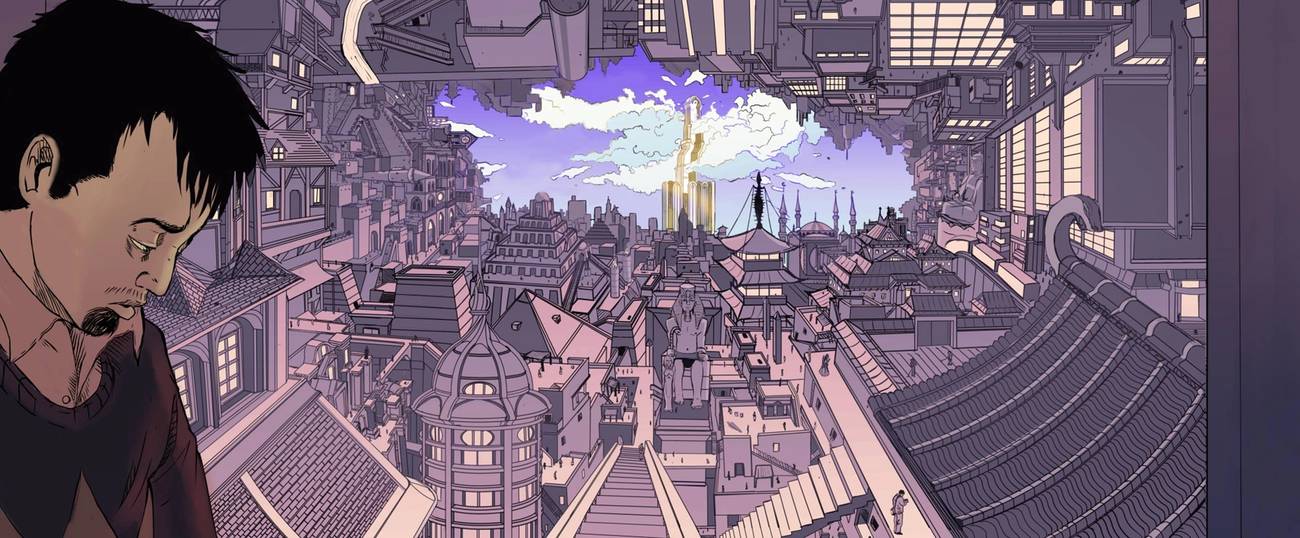In 2019, Israel Turned Japanese
The Jewish state’s affinity for anime dreamscapes comes alive in a new award-winning graphic novel




My two most significant Israeli cultural experiences of 2019 came from a graphic novel and a music video. Both are highly reflective of the anxieties that shape 21st-century Israeli life, and both of them deal with these anxieties using the cultural vocabulary of a seemingly distant culture—Japan.
The graphic novel, Piece of Mind (originally titled חשבון של הנפש—the Jewish term for self-examination), written by Nimrod Frydman and illustrated by Guy Lenman, made headlines recently when it won the prestigious International Manga Award, given by the Japanese Ministry of Foreign Affairs for the global promotion of manga (Japanese comics) culture. This is actually the second time an Israeli graphic novel has won the award. Piece of Mind was preceded by The Divine, written by Boaz Lavie and illustrated by Asaf and Tomer Hanuka, which won the award in 2015.
Yet while the Hanuka brothers are among Israel’s most recognized and respected comic artists, both locally and globally, Piece of Mind grabbed the award seemingly out of nowhere. The book was published in very small quantities by relatively unknown creators, starting out as Lenman’s graduation project at the Shenkar art school.
Piece of Mind follows Itzik, a young Israeli man who, after his untimely death, finds himself in “limbo”—a bureaucratic nightmare realm, in which the souls of dead people must endure endless waiting lines before facing a committee that judges if they are worthy of transfer to heaven. Itzik’s committee repeatedly turns down his transfer request, arguing that he fails to recognize the negative aspects of the apathetic attitude he expressed throughout his life. To make matters worse, Itzik knows that the committee is correct: His attitude has led to a tragic incident, and he is haunted by guilt. Still desperate to be transferred to heaven, Itzik approaches a mysterious woman who runs a dubious business that promises to help committee rejects to achieve their wishes.
What was it about Piece of Mind that caught the attention of Japanese award judges? In terms of design and page layout, there isn’t much about it that corresponds with the Japanese style—in fact, it recalls the Hanuka brothers’ portrayal of Israeli characters as somber people in somber surroundings. A notable exception is the mysterious woman who promises to help the protagonist, who does feature a “manga girl” look. But the appeal to Japanese judges probably lay deeper within the graphic novel’s themes.
Israeli readers of Piece of Mind will probably giggle at the portrayal of the afterlife as a version of Israeli government institutes where people must wait patiently for their appointments—and Japanese readers will probably identify with the experience of patiently waiting in long, endless lines.
I am guessing, though, that it’s the graphic novel’s main theme that caught the award judges’ attention: Should apathy be criminalized? A surprising number of Israelis will probably answer this question positively, as extroverted portrayals of emotion are often considered to be very typical of Israeli behavior and keeping one’s emotions in check is often frowned upon—in contrast to Japan.
Yet Frydman and Lenman ask if the Israeli open attitude to emotion is in fact a cover for something darker, turning Piece of Mind into a surprisingly complex and deep study of the Israeli soul—a remarkable achievement for a work that’s just under 80 pages.
***
Another striking examination of the Israeli psyche, also deeply rooted in Japanese culture, is offered in the 2019 music video for “Kirkarat Zahav” (“Golden Carriage”), a song by folk-rock musician Tomer Yeshayahu. Haaretz critic Ben Shalev called Yeshayahu “one of the most obsessive wanderers of current Israeli music,” as many of his songs take listeners to different locations along the Israeli landscape. Yet there is no specific reference to any Israeli geographic location in “Kirkarat Zahav.” The enigmatic lyrics appear to refer to a failed relationship, recounted by a woman who recalls drawing comfort from her boyfriend’s lies about how the relationship was going to last, even though they both knew it wouldn’t.
Yeshayahu’s song could be from anywhere. It is the beautiful animated music video that accompanies the song—directed by Tom Engler and Danielle Peleg of Studio Chapachka—that gives the song a strong Israeli context in both its nostalgic references to an Israel of the past, and strong connection to the familiar Israeli reality of 2019.
The video follows a young woman, driving across the country, picking up different hitchhikers, in a desperate and failed search of a meaningful connection. The video’s backgrounds are a love song to Israeli landscapes, from the familiar sights of Tel Aviv and Haifa to typical road landmarks like shielded bus stops and the yellow gas stations. However, the passengers picked up by the protagonist are not Israeli. They are Swedish, and Finnish, and Italian, and American and British, and above all Japanese. They represent another Israeli love song, a love song for a lost Israeli childhood.
Sound confusing? It won’t be to the Israeli children of the 1980s and the early 1990s, a time when Israel’s national broadcast channel had little competition, and animated adaptations of the great masterpieces of children’s literature ruled children’s broadcasting blocks. A generation of Israeli children fell in love with the works of L. Frank Baum, Tove Jansson, Lucy Maud Montgomery, and J.M. Barrie, among many others, through animated 52-episode runs throughout the school year, and reruns during summer vacations. For especially curious children who couldn’t wait to see how these stories ended, the programs provided an incentive to go to the library and pick up the original books.
While these shows were made by different studios, they all came from the same country: Japan. Long-running adaptations of Western children’s literature became a big business on Japanese television in the 1970s and ’80s, and their productions employed top talents from the country’s prolific animation industry, notably the young Hayao Miyazaki (future director of Totoro, Princess Mononoke, Kiki’s Delivery Service, and the Academy Award-winning Spirited Away) and Mamoru Oshii (who later directed the 1995 cult cyberpunk film Ghost in the Shell).
Israeli children were vaguely aware that the shows they were watching were Japanese, but they didn’t care much—anime fandom wasn’t a thing in Israel back then (it was barely a thing anywhere else) and they were too young to wonder why an animated adaptation of an Italian book should have Japanese end-credits.
The release of the video, however, makes this connection explicit, from the Japanese titles at the beginning to the identity of the different hitchhikers picked up by the protagonist. They are all grown-up versions of the kid characters from the animated adaptations that Israeli children grew up watching. Peter Pan, Anne Shirley from Anne of Green Gables, and Little My from Moomin are all seen in the video in their familiar designs from the shows, only as older, bitter people.
Two of the characters picked up by the video’s protagonist are worthy of special attention. One is Nils, the hero of Selma Lagerlöf’s classic book about a bad boy shrunken to a tiny size who joins a flock of wild geese in a journey across Sweden. Other than a moral story of a bad boy who learns proper behavior, Lagerlöf’s book is aimed primarily at teaching Swedish children about the geography and history of their country. For the children of Israel in the 1960s, the novel did the exact same thing. Etzbeoni, the young country’s leading children’s magazine, ran an illustrated local adaptation in which the protagonist (now named “Gil”) flies on the back of the goose on a journey across Israeli landscapes, learning of different places and their people.
By the time the Japanese animated adaptation aired on Israeli television in the mid-’80s, the Israeli children who read Etzbeoni’s localized version had become parents themselves; watching the show with their children must have felt like coming full circle. In the music video, though, Nils is now a grown-up, who at first appears to accept the protagonist’s offer of a romantic relationship, though his mind keeps wandering to his days as a child who flew freely in the sky. Even as a grown-up, Nils cannot shake his wanderlust, whereas the protagonist wishes to find a place to rest and settle down.
Another famous wanderer picked up by the video’s protagonist is the hero of From the Apennines to the Andes, a short story within Edmondo De Amicis’ 1886 seminal novel Cuore (“Heart”). The story followed a courageous Italian child named Marco, who goes on a tough journey from Italy to Argentina to find his mother, after letters from her stopped coming. As with other stories in De Amicis’ book, it’s a story with a strong patriotic subtext, emphasizing the national pride young Italian boys should feel. This subtext was not lost on pedagogues all over the world, especially in countries that gained or struggled for their independence—including both Japan and Israel. Zionist-oriented publications for children have featured Hebrew translations of stories from the book as early as 1903, with two separate translations of the entire book appearing in the 1950s. Cuore also made quite an impact on Japanese culture, notably inspiring the acclaimed Japanese poet Kenji Miyazawa.
The Japanese animators knew that they were dealing with a classic, and gave it the respect it deserves, expanding the short scope of From the Apennines to the Andes to a long, ongoing emotional affair. Upon its Israeli broadcast in the following decade, the show became a classic for the local audience in its own right, again appealing to both adults who remembered reading the book in their youth and to their children. The first-rate dubbing and translation, especially evident in the show’s theme song, are still regarded as a high standard that Hebrew dubs should meet:
In the music video, Marco is no longer a young boy but an adult who joins the protagonist’s ride, but he can’t shake his childhood memories. The hardships he went through in the animated adaptation left him traumatized. He can’t bring himself to joining a carefree afternoon with the protagonist and a couple of beers.
The final hitchhiker picked up by the protagonist is different. He is none other than the singer Tomer Yeshayahu, who leads her all the way to Tel Aviv, and offers for her to come with him—signaling that her journey is over, she finally found a person with whom she can stay. But just as she considers this offer, the ground underneath her car breaks down, keeping her forever separated from whatever solace she might have found.
At the video’s conclusion, we see the map of Israel broken into many tiny islands. The days in which Japanese-animated adaptations of classic children’s literature brought Israeli children together in a joint viewing experience on a single TV channel are long gone, and Israeli society at the closing of the 2010s is deeply fragmented.
If Piece of Mind dealt with the inner emotional difficulties of Israeli existence, the video for “Kirkarat Zahav” deals with the social circumstances at the root of these difficulties—the broken childhood promises of solidarity and friendship. The superb use of Japanese themes in both works points, perhaps, to a surprisingly strong connection between two seemingly dissimilar, even opposite cultures.
***
You can help support Tablet’s unique brand of Jewish journalism. Click here to donate today.
Raz Greenberg, an animation researcher, is the author of Hayao Miyazaki: Exploring the Early Work of Japan’s Greatest Animator.
Raz Greenberg, an animation researcher, is the author of Hayao Miyazaki: Exploring the Early Work of Japan’s Greatest Animator.